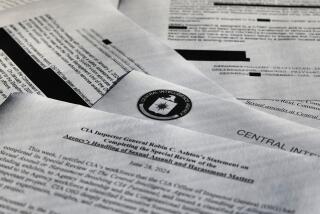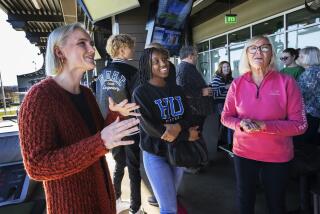Suspect in ’93 Shooting Spree at CIA Captured
- Share via
WASHINGTON — Mir Aimal Kansi, the alleged gunman in a ruthless 1993 shooting spree outside CIA headquarters that left two agency employees dead and three others wounded, has been captured and secretly brought back to the United States to face murder charges, the CIA and FBI announced Tuesday.
Kansi, a Pakistani immigrant, coldly machine-gunned motorists stuck in morning rush-hour traffic at an intersection outside the CIA’s headquarters in Langley, Va., U.S. officials charge. He was turned over to American officials by Afghans cooperating with the FBI and CIA, the government said. Officials said that Kansi, who is being held in the Fairfax County Jail, is expected to be arraigned in a Fairfax County court this morning. He faces state murder charges and could get the death penalty if convicted.
After fleeing the United States for Pakistan after the shooting, Kansi, now 33, had managed for more than four years to elude one of the most intensive international manhunts ever mounted by U.S. law enforcement and intelligence operatives.
U.S. officials frequently have complained that the Pakistani government was unwilling to cooperate in the Kansi search, making it far more difficult for FBI and CIA officers to corner him in his native province of Baluchistan in the rugged triangle where Pakistan, Iran and Afghanistan meet.
Kansi has been a fixture on the FBI’s most-wanted list and his arrest has long been one of the CIA’s highest priorities. Secret CIA-FBI paramilitary operations to capture him inside Pakistan or Afghanistan--authorized under a presidential covert action order on the international apprehension of terrorists--had been attempted repeatedly without success.
Once Kansi was identified as the prime suspect soon after the shootings, his origins led to speculation that his actions were somehow motivated by revenge for the CIA’s role in the Afghan war in the 1980s--and thus might be what the CIA calls “blowback” from its Afghan covert actions. Baluchistan was said to be a key staging area for CIA arms shipments to the Afghan rebels.
At the time, the Jan. 25, 1993, shooting spree outside CIA headquarters was one of the most brutal acts of international terrorism ever mounted inside the United States and certainly was one of the most frightening. It exploited a sense of claustrophobia that almost all Americans share about being trapped in rush-hour gridlock.
As CIA employees were driving to work just before 8 a.m., Kansi allegedly stopped his car on Virginia Route 123, got out, pulled out an AK-47 assault rifle and calmly began firing through windows as he walked up and down a line of cars waiting to turn into the CIA entrance. The gunman’s first victim was Frank Darling, a 28-year-old CIA communications expert who was sitting in his Volkswagen with his wife beside him.
Kansi allegedly fired at least 70 rounds as he moved down the line of cars, also killing Lansing Bennett, a 66-year-old physician and CIA intelligence analyst. Two of the three wounded were also CIA employees.
In the panic and confusion after the shooting, Kansi allegedly was able to drive away and slip out of the country before the FBI announced that it had begun a worldwide search for him. A gun shop owner in Chantilly, Va., had seen an FBI composite sketch of the suspect and matched him through his gun purchase records.
By then Kansi had made his way back to his Pakistani hometown of Quetta, where he appeared to benefit from the protection of his extended family and perhaps from his family’s political influence with the Pakistani government.
Over the years, the CIA developed a detailed psychological profile of Kansi and concluded that he was the underachieving son of a prominent Pakistani family who burned with the desire to make a name for himself. His father, Abdullah Jan Kansi, was a prominent leader in Quetta and was able to send his son to a local university.
In 1991, Kansi came to the United States and applied to the Immigration and Naturalization Service for political asylum in the Washington suburb of Arlington, Va., about a year later. By 1993, Kansi was living in Reston, Va., outside Washington with a roommate, Zahed Ahmad Mir, who allegedly accompanied him to buy the AK-47 used in the assault.
Mir later told authorities that Kansi said he was angered by the fact that the United States was not doing enough to help the besieged Muslims in Bosnia and told Mir that he planned to “make a big statement” by shooting up the CIA, the White House or the Israeli Embassy.
In a joint CIA-FBI statement Tuesday night, Acting CIA Director George J. Tenet exulted over Kansi’s capture, saying that “we have always kept the faith. . . . Today marks a clear triumph of good over evil.”
The arrest “in no way lessens the pain of those wounded . . . nor the despair experienced by the families who lost a loved one but it is my sincere hope that seeing Kansi brought to justice will provide some small solace,” he said.
FBI Deputy Director William Esposito added that Kansi’s arrest was attributable to cooperation not only between the CIA and the FBI but with the State Department as well.
Although the CIA-FBI statement referred only to the cooperation of individual Afghans, there were reports Tuesday night that the Pakistani government finally had been pressured to cooperate in Kansi’s apprehension after years of inaction and foot-dragging. That would mark a significant shift in the region, since the United States previously has relied on individual CIA informants rather than the government itself.
* SAUDI DEPORTED TO U.S.: Authorities hope for clues in blast that killed 19 airmen. A4
More to Read
Sign up for Essential California
The most important California stories and recommendations in your inbox every morning.
You may occasionally receive promotional content from the Los Angeles Times.













